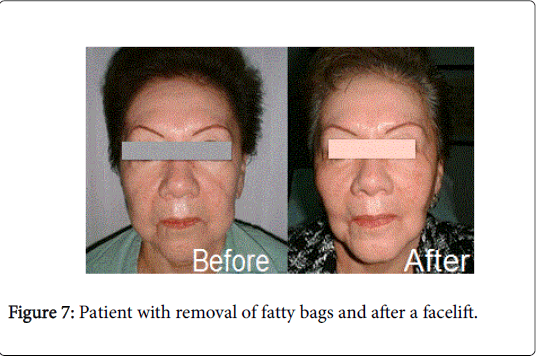The Buccal Fat Pads (Preliminary Report)
Received: 19-Mar-2018 / Accepted Date: 21-Mar-2018 / Published Date: 27-Mar-2018
Abstract
The buccal fat pad (BFP) is located anterior to the masseter muscle and deep to the buccinator muscle. It is a specialized fat tissue in human body. The buccal fat pad flap is an axial flap and may be used to fill small-to-medium sized soft tissue and bony defects in the palate, superior and inferior alveoli and buccal mucosa. The presence of buccal fat pad is somewhere advantageous during oral and maxillofacial procedures, in patients of the third age; I recommend the removal of the buccal pads prior to schedule a surgery of facial aging to avoid the appearance of "weight gain" and the facial flaccidity, as a result of surgery.
Keywords: Buccal fat pad; Facial flaccidity; Facelifting; Zygomatic ligaments; Platysma
Introduction
The buccal fat pad is a specialized type of fat that facilitates the intramuscular movement. It is located in the masticatory space associated with the muscles of mastication, superficial to the SMAS and covers the orbicularis oculi, the zygomatic and the muscles of the elevator. It is adherent to the skin and pass through the zygomatic ligaments. Extends laterally on the masseter muscles and the buccinators muscle deep to the plane of the conduit parotid and branches of the facial nerve and extends forward to the facial vessels [1]. Medially, could reach space pterygopalatine and an extension is superficial to the muscle and tendon is separated from the fat of the package of the deeper level of the temporal fascia (Figure 1). It presents a main body and 4 extensions from the region up to the cheek, passing through the malar zygomatic tunnel and the pterygomandibular space. The body and the oral extension contribute to the contour of the cheek.
Materials and Methods
Buccal fat pad are more prominent in: obese, mestizos and oriental. Their size is correlated poorly with the degree of adiposity of the patient. There are no variations between one side and another in the same individual. The surgery of the buccal fat pads allows reducing the width of the face, by the accumulation of fat.
This simple procedure allows improving the aesthetics of the face, making it look more slender and young [2]. The loss of the cheek due to the relaxation and stretching of the connection between the superficial and deep fascia results in the development of a suspension of skin, fat, and the platysma that forms in the lower middle line with age [3].
It is normal found in all individuals, worsens with age. This is why in some patients who come to a facelift surgery is performed in the first instance the removal of the buccal fat pads to reduce the width of the face (Figure 2). Clinical cases of patients who were resected fatty bags only and as a result facial flaccidity, waiting for a facelift are shown in below figures (Figures 3 and 4).
With the age, the malar fat along with the skin that covers it glides above a plane superficial to the SMAS and the orbicularis oculi and levator muscles to push against the underlying nasolabial fold. This slip of the skin and the malar fat increases the prominence of the nasolabial fold, creating an appearance associated with age [4].
And a second time will have increased laxity of the skin and consequently better result in the facelift. Clinical cases of patients are shown in the below figures who were resected fatty bags and after a face-lifting (Figures 5-7).
Conclusion
On the cheek senile, the fatty bags push out the buccal fat pad, which in turn pushes to the layer of fat under the skin of the cheek and jowls, forming a volume undesirable, the resulting of the buccinator muscle spasm causes the thinning of the face and facial flaccidity, which with the facelift in a second time, it manages to improve the facial contour.
References
- Stuzin JM, Wagstrom L, Kawamoto HK, Baker TJ, Wolfe SA (1990) The anatomy and clinical applications of the buccal fat pad. Plast Reconstr Surg 85: 29-37.
- Matarasso A (1991) Buccal fat pad excision: Aesthetic improvement of the midface. Ann Plast Surg 26: 413-418.
- Hasse FM, Lemperle G (1994) Resection and augmentation of Bichat’s fat pad in facial contourning. Eur J Plast Surg 17: 239-242.
- Guerrerosantos J (2007) Treatment of Persistent Jowls. J Aesth Surg 27: 329-335.
Citation: Olivares J, Torres E (2018) The Buccal Fat Pads (Preliminary Report). Cosmetol & Oro Facial Surg 4: 128.
Copyright: © 2018 Olivares J, et al. This is an open-access article distributed under the terms of the Creative Commons Attribution License, which permits unrestricted use, distribution, and reproduction in any medium, provided the original author and source are credited.
Share This Article
Open Access Journals
Article Usage
- Total views: 12169
- [From(publication date): 0-2018 - Apr 05, 2025]
- Breakdown by view type
- HTML page views: 11322
- PDF downloads: 847







